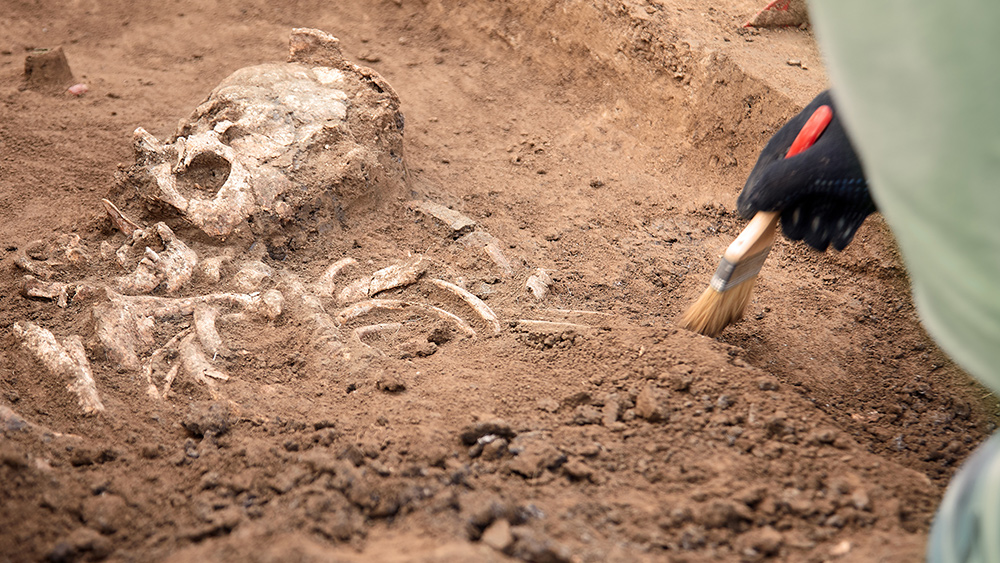Ancient human remains unearthed in Ethiopia older than previously thought, reveals study
07/15/2022 / By Zoey Sky

Researchers say that the ancient human fossils initially found in Ethiopia are much older than previously thought. In fact, it’s possible that the fossils are at least 230,000 years old.
The remains, called Omo I, were unearthed in Ethiopia in the late 1960s. The fossils are one of the oldest known examples of Homo sapiens fossils and experts previously dated them at under 200,000 years old.
But the study conducted at the University of Cambridge revealed that the Omo I fossils have to pre-date a colossal volcanic eruption in the area, which happened 230,000 years ago. Details of the study were published in the journal Nature.
For the study, the research team dated the chemical fingerprints of volcanic ash layers that were found above and below sediment where the fossils were first unearthed. The researchers took pumice rock samples from the volcanic deposits and ground them down to sub-millimeter size to date the volcanic remains.
While this pushes the minimum age for Homo sapiens in eastern Africa back by 30,000 years, future studies may extend the age even further.
Back in 2017, archaeologists announced the discovery of the world’s oldest Homo sapiens fossils: a 300,000-year-old skull at Jebel Irhoud, Morocco.
The Omo I remains were found in the Omo Kibish Formation in southwestern Ethiopia, which is found within the East African Rift valley. The location is an area of high volcanic activity and a rich source of ancient human remains and artifacts.
After dating layers of volcanic ash above and below where fossil materials are found, the research team was able to identify Omo I as one of the earliest examples of the human species ever found.
Dr. Celine Vidal from Cambridge’s Department of Geography and the paper’s lead author said that using these methods, the generally accepted age of the Omo I fossils is under 200,000 years. However, there remains a lot of uncertainty around this date. She added that the fossils were discovered in a sequence, below a thick layer of volcanic ash that nobody has managed to date since the ash is too fine-grained.
The four-year project, spearheaded by Professor Clive Oppenheimer, a British volcanologist, is trying to date all major volcanic eruptions in the Ethiopian Rift.
Vidal explained that every eruption has a unique “fingerprint” or an evolutionary story below the surface, which is determined “by the pathway the magma followed.” Crushing the rock frees the minerals within, which are then used to date them and identify the chemical signature of the volcanic glass that holds the minerals together.
Scientists conducted geochemical analysis on the crushed rock to link the fingerprint of the volcanic ash from the Kamoya Hominin Site with an eruption of the Shala volcano. Next, the research team dated pumice samples from the volcano to 230,000 years ago. (Related: Unique swords discovered in Byzantine Empire stronghold.)
According to the researchers, since the Omo I fossils were found deeper than this particular ash layer, they could be over 230,000 years old.
Vidal said that when she first discovered that there was a geochemical match, the ream didn’t have the age of the Shala eruption. She then sent samples of the Shala volcano to their colleagues in Glasgow to help them determine the age of the rocks.
After Vidal received the results, she realized that the oldest Homo sapiens from the region was older than previously thought.
Professor Asfawossen Asrat, a study co-author from Addis Ababa University in Ethiopia, added that the Omo Kibish Formation is an extensive sedimentary deposit that was “barely accessed and investigated in the past.”
Upon closer study of the stratigraphy of the Omo Kibish Formation, especially the ash layers, the researchers were able to push the age of the oldest Homo sapiens in the region to at least 230,000 years. Stratigraphy is a scientific discipline that is concerned with “the description of rock successions and their interpretation in terms of a general time scale.”
Omo I has definite modern human characteristics
Unlike other Middle Pleistocene fossils which are believed to belong to the early stages of the Homo sapiens lineage, Omo I has definite modern human characteristics, said Dr. Aurelien Mounier, a study co-author from the Musee de l’Homme in Paris.
Mounier cited the example of a “tall and globular cranial vault and a chin” and claimed that the new date estimate made the remains “the oldest unchallenged Homo sapiens in Africa.”
Until the Jebel Irhoud discovery four years ago, many experts thought that all humans living today descended from a population that lived in East Africa around 200,000 years ago.
Vidal said that experts can only date humanity based on the fossils that they have, making it difficult to figure out that this is the definitive age of the human species. But the study of human evolution is always in motion and “boundaries and timelines change as our understanding improves.”
The Omo I fossils also illustrate how resilient humans are and how they can live in a location that was prone to natural disasters.
Watch the video below to know more about ancient Hebrew artifacts discovered in Native American mounds.
This video is from the YAHZWILL YAHUDAH channel on Brighteon.com.
More related stories:
Experts unearth unique leather scale armor at 2,500-year-old Chinese burial site.
Researchers find world’s oldest stone tools in Kenya.
Researchers discover what may be the largest land drawings ever made.
Sources include:
Submit a correction >>
Tagged Under:
ancient history, archaeological sites, Archaeology, artifacts, breakthrough, discoveries, Ethiopia, fossils, Homo sapiens, Omo 1 Homo sapiens, real history, research
This article may contain statements that reflect the opinion of the author





















